+ データを開く
データを開く
- 基本情報
基本情報
| 登録情報 | データベース: PDB / ID: 7p02 | |||||||||||||||||||||||||||
|---|---|---|---|---|---|---|---|---|---|---|---|---|---|---|---|---|---|---|---|---|---|---|---|---|---|---|---|---|
| タイトル | Human Neurokinin 1 receptor (NK1R) substance P Gs complex | |||||||||||||||||||||||||||
 要素 要素 |
| |||||||||||||||||||||||||||
 キーワード キーワード | MEMBRANE PROTEIN / Receptor / Complex / Eukaryotic protein | |||||||||||||||||||||||||||
| 機能・相同性 |  機能・相同性情報 機能・相同性情報substance P receptor binding / substance P receptor activity / tachykinin receptor activity / positive regulation of flagellated sperm motility / aggressive behavior / Tachykinin receptors bind tachykinins / sperm ejaculation / positive regulation of uterine smooth muscle contraction / insemination / positive regulation of synaptic transmission, cholinergic ...substance P receptor binding / substance P receptor activity / tachykinin receptor activity / positive regulation of flagellated sperm motility / aggressive behavior / Tachykinin receptors bind tachykinins / sperm ejaculation / positive regulation of uterine smooth muscle contraction / insemination / positive regulation of synaptic transmission, cholinergic / detection of abiotic stimulus / operant conditioning / positive regulation of lymphocyte proliferation / tachykinin receptor signaling pathway / response to ozone / sperm head / response to auditory stimulus / positive regulation of action potential / positive regulation of hormone secretion / smooth muscle contraction involved in micturition / regulation of smooth muscle cell proliferation / positive regulation of blood pressure / positive regulation of vascular permeability / positive regulation of ossification / regulation of smooth muscle cell migration / positive regulation of leukocyte migration / response to pain / eating behavior / associative learning / behavioral response to pain / angiotensin-mediated drinking behavior / sperm flagellum / PKA activation in glucagon signalling / positive regulation of epithelial cell migration / hair follicle placode formation / long-term memory / developmental growth / neuropeptide signaling pathway / D1 dopamine receptor binding / intracellular transport / vascular endothelial cell response to laminar fluid shear stress / renal water homeostasis / response to electrical stimulus / Hedgehog 'off' state / positive regulation of protein localization to cell cortex / Adenylate cyclase inhibitory pathway / T cell migration / adenylate cyclase-activating adrenergic receptor signaling pathway / activation of adenylate cyclase activity / D2 dopamine receptor binding / positive regulation of stress fiber assembly / response to prostaglandin E / G protein-coupled serotonin receptor binding / adenylate cyclase regulator activity / adenylate cyclase-inhibiting serotonin receptor signaling pathway / positive regulation of vasoconstriction / sensory perception of pain / sperm midpiece / cellular response to forskolin / regulation of insulin secretion / cellular response to glucagon stimulus / regulation of mitotic spindle organization / adenylate cyclase activator activity / response to progesterone / positive regulation of epithelial cell proliferation / trans-Golgi network membrane / positive regulation of synaptic transmission, GABAergic / Regulation of insulin secretion / response to nicotine / negative regulation of inflammatory response to antigenic stimulus / positive regulation of cholesterol biosynthetic process / G protein-coupled receptor binding / cellular response to nerve growth factor stimulus / adenylate cyclase-inhibiting G protein-coupled receptor signaling pathway / bone development / adenylate cyclase-modulating G protein-coupled receptor signaling pathway / G-protein beta/gamma-subunit complex binding / response to peptide hormone / centriolar satellite / platelet aggregation / cognition / Olfactory Signaling Pathway / Activation of the phototransduction cascade / G beta:gamma signalling through PLC beta / Presynaptic function of Kainate receptors / Thromboxane signalling through TP receptor / G protein-coupled acetylcholine receptor signaling pathway / adenylate cyclase-activating G protein-coupled receptor signaling pathway / G-protein activation / Activation of G protein gated Potassium channels / Inhibition of voltage gated Ca2+ channels via Gbeta/gamma subunits / Prostacyclin signalling through prostacyclin receptor / G beta:gamma signalling through CDC42 / Glucagon signaling in metabolic regulation / G beta:gamma signalling through BTK / Synthesis, secretion, and inactivation of Glucagon-like Peptide-1 (GLP-1) / ADP signalling through P2Y purinoceptor 12 / Sensory perception of sweet, bitter, and umami (glutamate) taste / photoreceptor disc membrane / Glucagon-type ligand receptors 類似検索 - 分子機能 | |||||||||||||||||||||||||||
| 生物種 |   Homo sapiens (ヒト) Homo sapiens (ヒト) | |||||||||||||||||||||||||||
| 手法 | 電子顕微鏡法 / 単粒子再構成法 / クライオ電子顕微鏡法 / 解像度: 2.87 Å | |||||||||||||||||||||||||||
 データ登録者 データ登録者 | Thom, C. / Ehrenmann, J. / Vacca, S. / Waltenspuhl, Y. / Schoppe, J. / Medalia, O. / Pluckthun, A. | |||||||||||||||||||||||||||
| 資金援助 |  スイス, 2件 スイス, 2件
| |||||||||||||||||||||||||||
 引用 引用 |  ジャーナル: Sci Adv / 年: 2021 ジャーナル: Sci Adv / 年: 2021タイトル: Structures of neurokinin 1 receptor in complex with G and G proteins reveal substance P binding mode and unique activation features. 著者: Cristian Thom / Janosch Ehrenmann / Santiago Vacca / Yann Waltenspühl / Jendrik Schöppe / Ohad Medalia / Andreas Plückthun /  要旨: The neurokinin 1 receptor (NKR) is involved in inflammation and pain transmission. This pathophysiologically important G protein–coupled receptor is predominantly activated by its cognate agonist ...The neurokinin 1 receptor (NKR) is involved in inflammation and pain transmission. This pathophysiologically important G protein–coupled receptor is predominantly activated by its cognate agonist substance P (SP) but also by the closely related neurokinins A and B. Here, we report cryo–electron microscopy structures of SP-bound NKR in complex with its primary downstream signal mediators, G and G. Our structures reveal how a polar network at the extracellular, solvent-exposed receptor surface shapes the orthosteric pocket and that NKR adopts a noncanonical active-state conformation with an interface for G protein binding, which is distinct from previously reported structures. Detailed comparisons with antagonist-bound NKR crystal structures reveal that insurmountable antagonists induce a distinct and long-lasting receptor conformation that sterically blocks SP binding. Together, our structures provide important structural insights into ligand and G protein promiscuity, the lack of basal signaling, and agonist- and antagonist-induced conformations in the neurokinin receptor family. | |||||||||||||||||||||||||||
| 履歴 |
|
- 構造の表示
構造の表示
| ムービー |
 ムービービューア ムービービューア |
|---|---|
| 構造ビューア | 分子:  Molmil Molmil Jmol/JSmol Jmol/JSmol |
- ダウンロードとリンク
ダウンロードとリンク
- ダウンロード
ダウンロード
| PDBx/mmCIF形式 |  7p02.cif.gz 7p02.cif.gz | 220.6 KB | 表示 |  PDBx/mmCIF形式 PDBx/mmCIF形式 |
|---|---|---|---|---|
| PDB形式 |  pdb7p02.ent.gz pdb7p02.ent.gz | 168.7 KB | 表示 |  PDB形式 PDB形式 |
| PDBx/mmJSON形式 |  7p02.json.gz 7p02.json.gz | ツリー表示 |  PDBx/mmJSON形式 PDBx/mmJSON形式 | |
| その他 |  その他のダウンロード その他のダウンロード |
-検証レポート
| 文書・要旨 |  7p02_validation.pdf.gz 7p02_validation.pdf.gz | 899.1 KB | 表示 |  wwPDB検証レポート wwPDB検証レポート |
|---|---|---|---|---|
| 文書・詳細版 |  7p02_full_validation.pdf.gz 7p02_full_validation.pdf.gz | 908.8 KB | 表示 | |
| XML形式データ |  7p02_validation.xml.gz 7p02_validation.xml.gz | 35.8 KB | 表示 | |
| CIF形式データ |  7p02_validation.cif.gz 7p02_validation.cif.gz | 56.3 KB | 表示 | |
| アーカイブディレクトリ |  https://data.pdbj.org/pub/pdb/validation_reports/p0/7p02 https://data.pdbj.org/pub/pdb/validation_reports/p0/7p02 ftp://data.pdbj.org/pub/pdb/validation_reports/p0/7p02 ftp://data.pdbj.org/pub/pdb/validation_reports/p0/7p02 | HTTPS FTP |
-関連構造データ
- リンク
リンク
- 集合体
集合体
| 登録構造単位 | 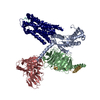
|
|---|---|
| 1 |
|
- 要素
要素
-Guanine nucleotide-binding protein ... , 3種, 3分子 BGA
| #2: タンパク質 | 分子量: 39086.641 Da / 分子数: 1 / 由来タイプ: 組換発現 / 由来: (組換発現)  Homo sapiens (ヒト) / 遺伝子: GNB1 Homo sapiens (ヒト) / 遺伝子: GNB1発現宿主:  参照: UniProt: P62873 |
|---|---|
| #3: タンパク質 | 分子量: 7861.143 Da / 分子数: 1 / 由来タイプ: 組換発現 / 由来: (組換発現)  Homo sapiens (ヒト) / 遺伝子: GNG2 Homo sapiens (ヒト) / 遺伝子: GNG2発現宿主:  参照: UniProt: P59768 |
| #4: タンパク質 | 分子量: 28428.365 Da / 分子数: 1 / 由来タイプ: 組換発現 / 由来: (組換発現)  Homo sapiens (ヒト) / 遺伝子: GNAI1, GNAS, GNAS1, GSP Homo sapiens (ヒト) / 遺伝子: GNAI1, GNAS, GNAS1, GSP発現宿主:  参照: UniProt: P63096, UniProt: P63092 |
-抗体 / タンパク質 / タンパク質・ペプチド / 非ポリマー , 4種, 4分子 HRP

| #1: 抗体 | 分子量: 32409.229 Da / 分子数: 1 / 由来タイプ: 組換発現 / 由来: (組換発現)  発現宿主:  |
|---|---|
| #5: タンパク質 | 分子量: 44218.668 Da / 分子数: 1 / 由来タイプ: 組換発現 / 由来: (組換発現)  Homo sapiens (ヒト) / 遺伝子: TACR1, NK1R, TAC1R Homo sapiens (ヒト) / 遺伝子: TACR1, NK1R, TAC1R発現宿主:  参照: UniProt: P25103 |
| #6: タンパク質・ペプチド | 分子量: 1348.637 Da / 分子数: 1 / 由来タイプ: 組換発現 / 由来: (組換発現)  Homo sapiens (ヒト) / 遺伝子: TAC1, NKA, NKNA, TAC2 Homo sapiens (ヒト) / 遺伝子: TAC1, NKA, NKNA, TAC2発現宿主:  参照: UniProt: P20366 |
| #7: 化合物 | ChemComp-CLR / |
-詳細
| 研究の焦点であるリガンドがあるか | N |
|---|---|
| Has protein modification | Y |
-実験情報
-実験
| 実験 | 手法: 電子顕微鏡法 |
|---|---|
| EM実験 | 試料の集合状態: PARTICLE / 3次元再構成法: 単粒子再構成法 |
- 試料調製
試料調製
| 構成要素 | 名称: NK1R in complex with Substance P, heterotrimeric mini-Gs chimera (Gsi) and scFv16 タイプ: COMPLEX / Entity ID: #1-#6 / 由来: RECOMBINANT |
|---|---|
| 由来(天然) | 生物種:  Homo sapiens (ヒト) Homo sapiens (ヒト) |
| 由来(組換発現) | 生物種:  |
| 緩衝液 | pH: 7.5 |
| 試料 | 濃度: 1 mg/ml / 包埋: NO / シャドウイング: NO / 染色: NO / 凍結: YES |
| 試料支持 | グリッドの材料: GOLD / グリッドのタイプ: Quantifoil R1.2/1.3 |
| 急速凍結 | 装置: FEI VITROBOT MARK IV / 凍結剤: ETHANE / 湿度: 100 % / 凍結前の試料温度: 277 K |
- 電子顕微鏡撮影
電子顕微鏡撮影
| 実験機器 |  モデル: Titan Krios / 画像提供: FEI Company |
|---|---|
| 顕微鏡 | モデル: FEI TITAN KRIOS |
| 電子銃 | 電子線源:  FIELD EMISSION GUN / 加速電圧: 300 kV / 照射モード: FLOOD BEAM FIELD EMISSION GUN / 加速電圧: 300 kV / 照射モード: FLOOD BEAM |
| 電子レンズ | モード: BRIGHT FIELD / 倍率(公称値): 130000 X / 最大 デフォーカス(公称値): 2400 nm / Calibrated defocus min: 800 nm / Cs: 2.7 mm |
| 試料ホルダ | 凍結剤: NITROGEN |
| 撮影 | 電子線照射量: 63.51 e/Å2 フィルム・検出器のモデル: GATAN K3 BIOQUANTUM (6k x 4k) |
- 解析
解析
| ソフトウェア | 名称: PHENIX / バージョン: 1.19.1_4122: / 分類: 精密化 | ||||||||||||||||||||||||||||
|---|---|---|---|---|---|---|---|---|---|---|---|---|---|---|---|---|---|---|---|---|---|---|---|---|---|---|---|---|---|
| EMソフトウェア |
| ||||||||||||||||||||||||||||
| CTF補正 | タイプ: PHASE FLIPPING AND AMPLITUDE CORRECTION | ||||||||||||||||||||||||||||
| 粒子像の選択 | 選択した粒子像数: 4227825 | ||||||||||||||||||||||||||||
| 3次元再構成 | 解像度: 2.87 Å / 解像度の算出法: FSC 0.143 CUT-OFF / 粒子像の数: 395052 / 対称性のタイプ: POINT | ||||||||||||||||||||||||||||
| 拘束条件 |
|
 ムービー
ムービー コントローラー
コントローラー






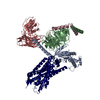


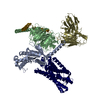
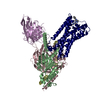
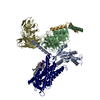

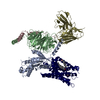
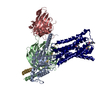
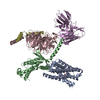
 PDBj
PDBj

































